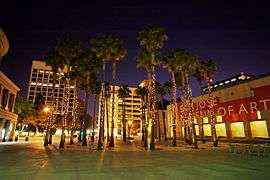Chinatown, San Jose, California
| San Jose Chinatown | |
|---|---|
| Neighborhood of San Jose | |
|
Circle of Palms Plaza and Fairmont at Night, almost all traces of Chinatown are gone from the area that was once a Chinatown | |
| Coordinates: 37°20′N 121°54′W / 37.333°N 121.900°W | |
| Country |
|
| State | California |
| County | Santa Clara |
| City | San Jose |
| ZIP Code | 95112 |
| Area code(s) | Area code 408 |
The city of San Jose was home to five Chinatowns that existed until the 1930s:[1]
- "First" Market Street Chinatown (1866–1870)
- Vine Street Chinatown (1870–1872)
- "Second" Market Street Chinatown (1871–1887)
- Woolen Mills Chinatown (1887–1902)
- "Heinlenville", also known as the Sixth Street Chinatown (1887–1931)[1]
Chinese American Demographics of San Jose
The city of San Jose is home to 63,434 Chinese Americans according to the 2010 U.S. Census, comprising 6.7% of the city's population.[2]
South 1st Street
The initial Chinatowns in San Jose were frequently burned down by arson, with artifacts from May 1887 recently discovered around the San Jose Institute of Contemporary Art, which is located at 560 South 1st Street.[3]
Market and San Fernando Streets: "Plaza Street Chinatown"
Another Chinatown was excavated during an urban renewal project to build the Fairmont Hotel and Silicon Valley Financial Center on Market and San Fernando Streets.[4] According to another article, this Chinatown was also known as the "Plaza Street Chinatown", which grew rapidly from the 1860s to the 1870s and was home to "... several hundred Chinese." According to this article , the area at the time was subject to controversy as many whites often complained to the city council about the area as "bothersome". By 1870, the area was burned to the ground with many Chinese evicted from the area as the anti-Chinese public sentiment grew.[5]
The following pictures were taken in the location of the old Plaza Street Chinatown, now the Circle of Palms Plaza:
-

State seal at center of the Circle of Palms
-

Night view of the Circle of Palms Plaza and the San Jose Museum of Art
-

San Jose Museum of Art and Circle of Palms
-

Circle of Palms and San Jose Museum of Art
Sixth Street and Cleveland Street: "Heinlenville"
John Heinlen, a farmer and businessman, planned a six block Chinatown with brick structures with water and pipes in the area of Sixth Street and Cleveland Street in 1887, to the dismay of the non-Chinese public and caused public outrage. The area was then known as "Heinlenville" and contained a variety of merchants, barbers, traditional doctors, and Chinese herbal medicine. and the Ng Shing Gung temple. The area was surrounded by Little Italy and co-existed harmoniously, but then dwindled in the 1920s as the younger generations sought careers outside the area and with a lack of new Chinese coming in due to the Chinese Exclusion Act, the area lost almost all of its Chinese population.[6] Some artifacts from this Chinatown are now located in Kelley Park. At the time, an existing Japantown nearby was evacuated due to the war, but was repopulated after the internment of the Japanese-Americans.
See also
- Chinese enclaves in Silicon Valley
- History of the Chinese Americans in San Francisco
- Japantown, San Jose
References
- 1 2 Lillian Gong-Guy, Gerrye Wong. Chinese in San Jose and the Santa Clara Valley.
- ↑ "American FactFinder".
- ↑ "Exhibit highlights artifacts from long-buried San Jose Chinatown".
- ↑ "City Beneath the City @ Stanford Archaeology Center".
- ↑ "Peck-Marked Vessels from the San José Market Street Chinatown: A Study of Distribution and Significance".
- ↑ "Part of San Jose History" (PDF).
External links
- Connie Young Yu (2001). Chinatown, San Jose, USA. San Jose Historical Museum Association. ISBN 978-0914139126.